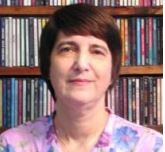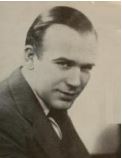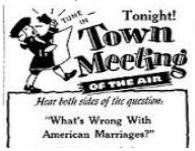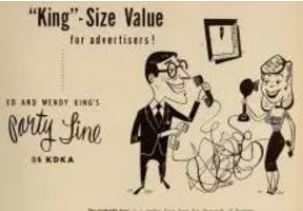The Early Years of Call-In Talk Radio

[June 2017] A mainstay of radio stations across the country is the talk format. From the political to the do-it-yourself to telephone swap meets to all-night talkathons, call-in shows can be radio communication at its best – or enough to put someone to sleep.
How and when the genre got started is the topic Donna Halper is focusing on in this two-parter.
Today, we take call-in talk radio for granted.
Listeners contact the station to speak to the host. At many stations, there is a call-screener who finds out what they want to talk about while, at others, the hosts themselves first screens the call to get some idea of what topic the caller hopes to discuss.
But either way, soon the conversation is on the air. Most stations utilize a delay, to prevent bad language from being broadcast, but otherwise, it is pure radio: the caller and the host engaging on air in a live conversation on a topic of interest to the community.
It was not always that simple.
Do Not Call, Do Not Talk
On the other hand, there was a time in the early 1920s when putting a caller on the air was not only illegal, it could cost a station its license.
Even mentioning that people had called your show was strongly discouraged by the DOC (Department of Commerce), the agency that supervised radio in the years before there was an FRC (Federal Radio Commission) or its later incarnation, the FCC (Federal Communications Commission).
In those formative years of radio, the DOC drew a hard line about what they called “direct communication.” According to the Radio Act of 1912 (which was created long before commercial broadcasting existed), all radio stations had to avoid “the transmission of acknowledgements to individuals relating to the receipt of letters, telegrams, and telephone calls.”
In fact, in early 1923, several radio magazines published a reminder from the DOC that radio stations were not allowed to broadcast “point-to-point” communication; they were not allowed to even mention the receipt of telephone calls, or telegrams, or letters, nor give the names of people who had gotten in touch. (For an example, see Wireless Age, March 1923, p. 46.)
Completely Different
This strict interpretation of the Radio Act of 1912 may have been influenced by something that occurred in 1921-1922, a time when it was hard to tell whether stations were amateur or commercial.
In those days, hams regularly filled in for their commercial radio colleagues during a time of unreliable transmitters. The problem was that broadcasting advertising messages (what today are called “commercials”) or any message for money was forbidden on ham stations. This led in 1922 to an order for ham stations to confine themselves to 200 meters and commercial stations staying on 360 meters needed to have commercial call letters.
Given the clearly official separation of amateur and commercial stations the DOC may have felt a stern reminder about the new rules was needed, including even one regarding mentioning the name of a listener requesting a song.
Herding Cats
For the most part, the radio stations of the early to mid-1920s seemed to fear what the DOC might do, and wanting to keep their licenses, followed the Rules they had been given.
That meant they could, and did, broadcast from remote locations (such as churches, county fairs, concert halls, etc.); but when it came to direct mentions of specific people in the audience, it was the newspapers and magazines that quoted people who were there, or published their opinions. Radio was still basically a one-way medium – programs were sent out, but there was no immediately way for listeners to respond.
Of course, at that point in time, few radio stations really gave any thought about putting live phone calls on the air. In addition to the DOC frowning on the very idea, it would not have been easy technically to accomplish.
Technological Problems
That does not mean it was technologically impossible.
Some of the broadcast engineers with whom I have spoken tell me that even in the 1920s, it could have been done, but the audio quality would have been poor. In fact, the engineers on the Internet Broadcast List had some interesting suggestions about how it might have been done.
While I am not an expert on 1920s technology, a suggestion from “Cowboy” Curt Flick notes that since candlestick phones had a dynamic coil-diaphragm ear piece, the station’s engineer could have tried wrapping a significant number of turns of wire on an iron core of some sort, and then put it up against the earpiece. This would create a rudimentary audio transformer, with no direct coupling to the phone or phone system.
Or the person on the air could hold the earpiece against one of the carbon microphones of that day – but that would undoubtedly have sounded quite distorted. And as Xen Scott pointed out, “The challenge would have been to maintain an audio balance between the studio talent and the caller. The concept of mix-minus was [well] in the future.”
Opening the Phone Lines
I would be interested in other theories about how a phone call in the early 1920s might have, theoretically, been put on the air.
Nevertheless, the fact remains that not many stations seemed to try it.
 Then, in late January 1929 popular singer and pianist Jack Little (known on stage as “Little Jack Little”) was doing a guest radio appearance at KSTP in St Paul MN. This was something he enjoyed, usually in conjunction with a performance he was doing locally. But this broadcast was unique: working with the station’s chief engineer Harry Geise, Jack delighted his fans by taking phone calls and putting them on the air.
Then, in late January 1929 popular singer and pianist Jack Little (known on stage as “Little Jack Little”) was doing a guest radio appearance at KSTP in St Paul MN. This was something he enjoyed, usually in conjunction with a performance he was doing locally. But this broadcast was unique: working with the station’s chief engineer Harry Geise, Jack delighted his fans by taking phone calls and putting them on the air.
As Radio Digest reported, he first put a caller from Dallas TX on the air; another called from Lima OH, then another from Milwaukee. The article did not mention the quality of the calls; the reporter just seemed amazed that it had happened at all. Another reporter, from the Associated Press, also wrote about this unique event, noting the long-distance conversation occurred thanks to a “special telephone-microphone pick-up.”
There is no evidence KSTP got in trouble, nor was their license put in jeopardy, leading me to surmise that the station got permission ahead of time from the FRC, which allowed the stunt to be broadcast.
Not Quite Common Yet
Nevertheless, talk radio as we know it was not on the horizon in the 1930s. In fact, by most accounts, it would not arrive till the late 1940s.
Meanwhile, a new kind of talk program, “America’s Town Meeting of the Air,” made its debut on NBC Blue on May 30, 1935.

Hosted by George V. Denny Jr., it was a national talk show, featuring high-profile panelists discussing the issues of the day. Some historians credit it with being the first of the genre.
“America’s Town Meeting” also had an often-fractious and outspoken studio audience which asked sometimes asked serious questions, but at other times heckled the guests or vehemently disagreed with them. There were also listening rooms set up at remote locations in various cities, where members of those audiences could step up to the microphone and ask a question.
True, it was not a telephone call-in show, but it was certainly a precursor, since it allowed members of the public from distant locations to talk with the guests and the host.
Please Call Us Now
It was not until sometime in 1947 or 1948 that we learn about efforts to allow guests to call into the station and get on the air.
 Among the early pioneers in this new style of radio was Joe Pyne, who started his radio career as a traditional announcer in smaller markets like Lumberton NC, Kenosha WI, Chester PA, and Atlantic City, NJ.
Among the early pioneers in this new style of radio was Joe Pyne, who started his radio career as a traditional announcer in smaller markets like Lumberton NC, Kenosha WI, Chester PA, and Atlantic City, NJ.
Gradually – to the annoyance of his bosses – he began inserting his opinions about politics into his radio shows. (Some sources say he first did so at WLIP in Kenosha, circa 1947.)
Although he kept having disputes with management and getting fired, he finally found a place for his idea.
By 1951 he was on the air a second time at WILM in Wilmington DE where he began doing a call-in program he called “It’s Your Nickel.” (The name referred to the fact that in the early 1950s, it cost five cents to call from a pay phone.)
Pyne quickly became known for controversial statements, and for arguing with his callers. But he became very successful at hosting the show. (More on Joe Pyne’s life and career here.)
Friendly Talk
Also in 1951, a very different kind of talk show, “Party Line,” made its debut at KDKA in Pittsburgh.

Hosted by a married couple named Ed and Wendy King, the program originally aired at midnight (it was later moved to 10 PM). By the summer of that year, it had listeners writing in from 41 states. This was a family-friendly show, where the Ed and Wendy tried to answer questions about anything, and sometimes they were asked to solve listeners’ problems.
 What was unique was that the voice of the caller was never heard. Either Ed or Wendy would relay what the caller had just said, and sometimes they would read letters from those who had written in.
What was unique was that the voice of the caller was never heard. Either Ed or Wendy would relay what the caller had just said, and sometimes they would read letters from those who had written in.
Somehow, the show worked and it remained extremely popular throughout the 1950s and 1960s, until Ed’s death in 1971.
Who’s Talking?
Up to the mid-1950s, it seemed to be a custom of early talk shows to just repeat what the caller was saying. Indeed, Pyne told an interviewer in 1952 that it would be too unpredictable and dangerous to just put a caller on the air live. Yet by 1957, that is exactly what Pyne was doing – arguing on air with listeners who called to debate him.
The Beep
While Joe Pyne and several other talk show hosts started to put callers on the air, there was a good reason why some late 1940s/early 1950s call-in hosts were reticent to do so – and it was no longer because of poor audio quality.
The real reason may have been due to a 1947 FCC ruling, “Use of Recording Devices,” which was implemented in 1948. The FCC decided it was a radio station’s duty to notify a caller that the call was going to be recorded and/or broadcast on the air: 0.2 second of 1400 kHz every 12 to 15 seconds. (This is still true: before any recording starts, permission must be sought.)
To make sure the caller knew he or she was being broadcast, the station was ordered to use “a distinct, audible tone warning (beep tone) signal at regular intervals during the conversation.”
The era of the 15-second beep tone had arrived.
Some talk show hosts must have found this bizarre; why would someone call a talk show if not to be put on the air to talk with the host? But there was nothing that could be done. I still remember as a kid, listening to Boston talk show host Jerry Williams in the late 1950s, and there it was, every 15 seconds – that annoying beep tone.
Although radio stations and the NAB lobbied the FCC frequently, the ruling remained in place till 1972.
Building Talk Radio Tech
Talk radio today is among the more popular formats in many markets.
Over the years, talk has moved from a general audience format to dozens of specific talk formats: political, sports, arts, car and home repair, religious, national, and totally local.
However, to get there, radio stations needed some new technology to deal with the sound quality, the increased need for a delay, and to be able to receive a call from almost anywhere on the planet.
In Part 2, we will discuss the evolution of talk radio since the late 1960s, as well as the technological improvements that have made it happen.
– – –
Donna L. Halper, PhD is an associate professor of Communication and Media Studies at Lesley University, Cambridge MA. She is the author of six books and many articles, a radio consultant, and a former broadcaster. Her website is: www.donnahalper.com
– – –
Would you like to know when more articles like this are published? It will take only 30 seconds to
click here and add your name to our secure one-time-a-week Newsletter list.
Your address is never given out to anyone.
